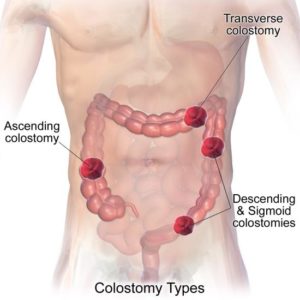Overview of the GI Tract
Your digestion starts at the mouth where your food is broken down while you chew and salivate.
When you swallow, the food travels down your esophagus to the stomach, where food is further chemically broken down by enzymes into a liquid-like form.
This semi-liquid food mixture is released into the small intestine. The food’s nutrients are absorbed into your bloodstream in the small intestine.
Everything not absorbed in the small intestine is pushed into the large intestine, or colon. The large intestine is responsible for absorbing water and storing your stool until you’re ready to eliminate it. The further down the colon the stool travels, the more solid and formed it becomes due to the water being absorbed as it travels.
After the colon, the stool passes through the rather short rectum, the sphincter muscles relax and the stool is expelled from your body via the anus.
When the entire colon is removed, an ileostomy is created
An ileostomy is a surgically created opening in the abdominal wall. The ileum (terminal part of the small intestine) is slightly pulled out of the hole in the abdomen in order to divert stool. The stoma of the ileostomy can be an end ileostomy or a loop ileostomy (see “The Stoma” section below).
Generally, an ileostomy is created when the colon and/or part of the small intestine is removed. Ileostomies are also sometimes for a temporary period of time, to allow part of the intestines to heal or rest.
When only part of the colon is removed, a colostomy is created
A colostomy is a surgically created opening in the abdominal wall. Part of the colon is slightly pulled out of the hole in the abdomen in order to divert stool. The stoma of the colostomy can be an end colostomy, a double barrel colostomy, or a loop colostomy (see “The Stoma” section below). The placement of the colostomy on a person’s abdomen depends on what part of the colon is used for the stoma.
A colostomy is generally created when part of the colon is removed. Colostomies are also sometimes created temporarily while allowing part of the intestines to heal or rest.
The Stoma
- Red, moist, and shiny
- The stoma does not have nerve endings, so you will not be able to feel the stoma
- You will be able to see your stoma move. This movement is called peristalsis and is the way your body naturally moves waste through your GI system.
- The stoma is very vascular, so it’s common that the stoma may bleed a small amount for a short amount of time, especially while the area is being cleaned and the stoma is being touched by your finger or a cloth. If the stool is bloody or the stoma bleeds heavily or for a longer period of time, contact your doctor.
It is normal for a stoma to change size and shape within the first eight weeks after surgery. As swelling goes down, the stoma will generally get smaller and look less taut.
Types of Stomas
Colostomy– a stoma made from a section of the colon that is brought outside of the body to divert stool
- The types of colostomies are: Ascending, Transverse and Descending Colostomies
Ileostomy– A stoma made from a section of the ileum of the small intestine that is brought outside of the body to divert stool
End Stoma– The end of the existing small intestine or colon left in the body is used to form the stoma
Loop Stoma– A loop of intestine is brought outside of the body and used to form the stoma. A slit is cut in the stoma to allow stool to exit. This type of stoma is generally temporary
Double Barrel Stoma– Both the proximal and disital ends of the intestine are pulled through the abdominal wall to form two stomas (after a section of the diseased intestine is removed)
Location of the Stoma
 Ascending Colostomy – stoma is located on the right side of the abdomen
Ascending Colostomy – stoma is located on the right side of the abdomen
Transverse Colostomy – located in the mid-upper abdomen or on the right side. The stoma is larger because the diameter of the transverse colon is larger than other sections of the colon
Descending/Sigmoid Colostomy – located on the left side of the abdomen if a descending colostomy, and the lower left side if a sigmoid colostomy
Ileostomy – located on the right lower quadrant of the abdomen (like an ascending colostomy, but smaller stoma)
Find related articles and resources about ostomy surgery below:
- What is an Ostomy? | Ostomy 101
- Preparing for Surgery
- What to Bring to the Hospital
- 10 FAQs about Ostomies
- Meet Laura Cox | Video
Shield HealthCare | Medical Supplies For Care At Home Since 1957


















